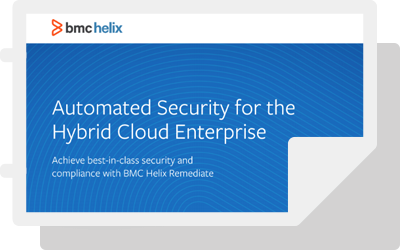IT operations tasks and processes have typically been manual, tedious, and rigid to ensure that changes are controlled and documented to prevent unplanned outages. However, as environments shift to agile infrastructures where speed is everything, automation of IT tasks and processes becomes critical. This is especially true in cloud environments where infrastructure is virtual and scalable and users demand immediate access and full control of deployed services. This places an increasing burden on IT Operations to enable faster change, while ensuring compliant, high performing applications.
Many public cloud players have emerged to support various needs “as-a-service,” from a simple virtual instance with an operating system, to a development platform, to a fully configured ecommerce website. Enterprise organizations are aggressively moving to cloud services as the choices allow for flexibility without the worry of infrastructure management. Furthermore, they are able to better accommodate future change that can occur as new technologies emerge or the need to scale to support growth.
“CloudOps” is an emerging term and trend that attempts to ensure that the benefits of cloud-based systems can be maintained without IT operations losing control. Just as DevOps seeks to enable continuous innovation and delivery of software changes from development through operations, CloudOps attempts to enable continuous operations and improvement in cloud environments. Many organizations have used the move to the Cloud as an opportunity to leverage new security models, architectures and technologies such as stateless computing and microservices. These technologies not only enable rapid scaling, but they also drive a fundamental change in the way that IT Operations must manage these services. For instance, deploying an agent and then registering with a management system is likely not fast enough nor practical when cloud services may only live for hours or minutes.
Yet, most enterprises that are adopting infrastructure on public clouds, still have a clear need for around-the-clock IT operational procedures. The key is to adopt new operational procedures that suit the demands of public clouds.
Because public clouds typically handle management of the infrastructure hardware and availability, enterprises can shift their focus to deploying and administering software to meet security, performance and budgetary goals. Effective CloudOps typically requires a cloud management platform that can consistently deploy software and configuration changes in accordance with corporate performance, governance and security policies across multi-source clouds.
The success of CloudOps initiatives largely depends on the following characteristics of a cloud management platform:
- Infrastructure instance management
- Governing policies for instances
- Relentlessly automating processes
- Adapting processes to new technologies
Infrastructure instance management
IT operations revolve around machine instances and how storage, networks, security, and management policies are applied to those instances. An instance can be a full application, a component of a tiered application, or a microservice. Cloud management platform tools can help integrate the management of all instances and dependent resources, regardless of where they are running through a single dashboard. With a consolidated dashboard and the right processes, cloud administrators can execute CloudOps practices universally across multi-source cloud environments to:
- better understand performance issues that could lead to downtime;
- deploy cloud services consistently across different public clouds;
- deliver cloud resources to users faster; and
- enable ongoing maintenance and security updates across clouds.
Maintenance and security updates are often afterthoughts in the rush to the cloud. With integrated CloudOps processes and tooling, you can manage compliance and patching of the complete infrastructure more efficiently. This includes generating reports and dashboard views of the entire infrastructure from one place.
The key benefit though is speed. With effective CloudOps processes and tooling, administrators can easily:
- Provide a self-service catalog of public and private cloud services that enables users to provision or de-provision resources based on daily needs.
- Give users the ability to modify their running instances
- View performance of cloud services
Governing policies for instances
As mentioned earlier, CloudOps is about providing continuous change and improvement of operations in the cloud. This often manifests itself by applying policies that help govern various aspects of cloud services. For example, one such policy might be to prohibit a user from provisioning more than 10 machines at a time or to limit the amount of hardware an application can use.
Policies can be technology or business oriented. Business policies can limit “who” in the organization is authorized to deploy cloud services, the type of cloud services that can be deployed or the authorized public or private cloud targets. Technical policies can, for instance, restrict the underlying technology that is used for certain types of applications to force alignment with internal architectural guidelines.
Relentlessly Automating Tasks and Processes
Key to the adoption of CloudOps is the shift towards automation of everything. Each manual task or process takes time that delays the delivery of services or the remediation of threats. Here are three key automations that can significantly enhance the effectiveness of CloudOps:
- Closed-loop change and configuration. Use of the cloud doesn’t remove the need to document changes or configurations, but instead, increases the pressure to be timely. Most enterprises manage change and configuration through an enterprise service desk. Integrating the cloud service catalog with ITSM service requests, can automate the approval process, sending some requests straight through to processing and stopping some for manual approval, all the while, documenting the changes to remain compliant with internal rules and external regulations. At BMC, we’ve seen customers reduce service delivery times by over 90% by automating this step alone, while also increasing service reliability and audit readiness.
- Self-service cloud access. Users, especially from the DevOps chain, want rapid access to cloud services so that they can code, test new features and innovate through experimentation. Establishing proper role based access control (RBAC) combined with business and technology policies for workload placement allows the IT Operations team to streamline and speed service provisioning, while still maintaining operational oversight to help ensure security, performance and budget goals are maintained.
- Cloud security remediation. Scanning tools can identify potential vulnerabilities in your cloud environment but without automation, those known issues will remain unchecked. Critical to maintaining a solid security posture is driving automation between the identification and remediation of vulnerabilities. This helps CloudOps administrators take remediation actions such as patching or changing configurations, quickly and effectively.
Adapting processes to new technologies
Open source software such as CloudFoundry, Docker and Spinnaker are rapidly emerging and influencing the way organizations develop and deliver software. As development organizations adopt and leverage these technologies, your CloudOps policies and processes should be sufficiently flexible to adapt. Some Cloud tools are hardwired to the technologies they support, complicating the adoption or switching to new technologies.
Your choices for CloudOps tooling and processes should consider the following:
- What are the needs of the applications? Are they traditional application architectures or new, stateless, microservices based architectures?
- What kind of deployment techniques do you plan to implement to ensure zero downtime during upgrades or maintenance?
- What are your planned target clouds? Do your supporting CMP and monitoring technologies support those clouds?
- How will you document changes to systems to minimize unplanned outages and streamline handoffs with the service desk?
Getting the most from your cloud with CloudOps
As enterprise workloads shift to public and private clouds, IT operations faces increasing challenges to maintain control while enabling flexibility and speed. Traditional IT operations are too rigid and hardwired to handle the dynamic nature and growing trends of cloud. For the best results, you’ll need to start by understanding the requirements of your cloud applications and your users. Then consider the tools and processes that will provide the right speed and access yet, still allows for proper visibility and governance, to enable oversight and management of technology and business priorities. Consider cloud tools that will help you:
- Scale during periods of rapid growth
- Adapt to changing public cloud providers
- Automate day-to-day operations tasks
- Allow self-provisioning across multiple public cloud platforms
- Include dashboards that reflect the various aspects involved in IT operations
- Proactively manage and automated remediation of security threats and non-compliance
If you would like to learn more about BMC solutions that enable CloudOps, check out the following:







